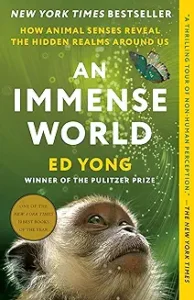An Immense World: How Animal Senses Reveal the Hidden Realms Around Us by Ed Yong 2022
Included on the New York Times’ list of Ten Best Books of 2022, Pulitzer Prize-winning Ed Yong’s exploration of how animals sense their environments is a masterful and fascinating look at a little-noticed world around us.
Yong introduces the book by referring to a 1909 work by a German zoologist, Jacob von Uexkull who introduced the term “umwelt” defined as the part of an animal’s surroundings that it can sense and experience, its perceptual world. Likening an animal’s body to a house, Uexkull wrote that “each house has a number of windows which open onto a garden—a light window, a sound window, an olfactory window, a taste window, and a great number of tactile windows. Depending on the manner in which these windows are built, the garden changes as it is seen from the house.” Yong takes this metaphor and does a deep dive into how the ‘houses’ of animals differ from those of humans and how these differences affect how various animals experience the world.
It turns out that except for excellent visual acuity, we humans have a quite limited set of senses. Dogs smell much more than we do. Snakes perceive heat much better than we do. Bats can ‘see’ with echolocation sonar, owls can ‘see’ with incredibly acute hearing, and moles and mice can ‘whisk’ with special hairs around their snouts to identify food in the pitch dark where we would be helpless. Knifefish use electric fields to identify prey that we could not possibly find in the turbid water where they live. And on and on, as Yong describes anatomical and neurobiological pathways that have evolved in other species to enable them to successfully survive—to eat, to move, to reproduce.
Yong often can get a bit lost in the weeds, providing the names of scientists and specifics of their experiments to the point where one’s eyes can glaze over, but his overall thesis and the proof he marshals in support of it is spot on—that the world is a far richer and a far more interesting and beautiful place than our limited senses can experience. In the final chapter, he brings all of this to bear in expressing concern that humans are destroying the habitats for these fellow travelers on planet earth and that this damage, from plastic islands in our oceans to light pollution that kills migrating birds and newly born turtles, will ultimately impoverish and perhaps even endanger our own lives.
I enjoyed Yong’s previous book about how the bacterial biome that inhabits our bodies is critical for our well-being and survival, and this book is similarly thought-provoking, educational, interesting, and well written. If you’re a science nerd, you’ll love it. If not, you may get bogged down around page 320 as he dives into the impact of magnetic fields on migrating birds and turtles, a sense that doesn’t appear to be located in any one organ in the body. But for those of you willing to soldier on, this is a terrific book!



